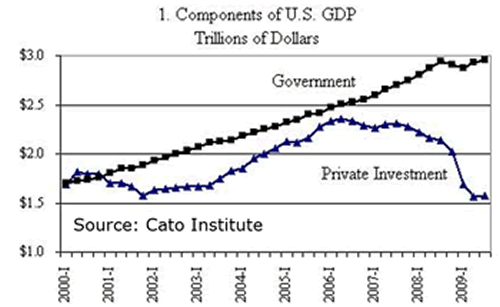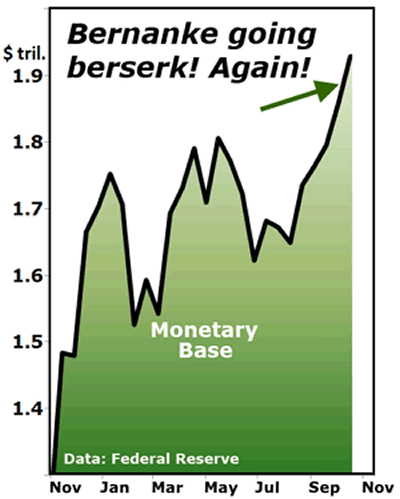Economic Recovery, The Great Hoax of 2009-2010
Economics / Economic Recovery Nov 02, 2009 - 07:40 AM GMTBy: Martin_D_Weiss
 Before he died, Dad warned me of false profits … and fake promises.
Before he died, Dad warned me of false profits … and fake promises.
“Beware,” he said, “of shaky gains hyped up by Wall Street.
“Watch out,” he insisted, “for unsustainable economic recoveries trumpeted by Washington.
“And no matter when or where you may be, don’t be fooled by illusions of wealth and prosperity.
“If they’re built on a foundation of shaky debt, they’re suspect. If they’re driven by unbridled speculation, they’re pure fluff. And if they’re bought and paid for by Washington, they will certainly end in catastrophe.”
Sure enough, in the years that followed, millions of Americans were fooled by illusions of wealth created by the Great Tech Bubble of 1998-1999.
Millions more were fooled for a second time by illusions of prosperity in the Great Housing Bubble of 2005-2006.
And now, despite these blatant lessons of history, they are being fooled again — this time, in …
The Great Recovery Hoax of 2009-2010
There can be no debate that, in each of these episodes, things did go up: The Nasdaq soared before it crashed. The median price of U.S. homes skyrocketed before it collapsed. And now, the U.S. economy has reversed course — from four consecutive quarters of contraction to at least one quarter of expansion.
There also can be no doubt that these trends do not end overnight. They can continue for months — often plowing over skeptics and even exceeding the expectations of believers.
Most important, however, there can be no question that all three of these episodes have had one key element in common that ultimately self-destructs: Massive intervention, support, and free money from Washington.
To get a solid sense of how that’s unfolding this time around, pay close attention to these three independent economists:
Jim Grant, Founder and Editor, Grant’s Interest Rate Observer
Jim Grant, originator of the “Current Yield” column in Barron’s and founder of Grant’s Interest Rate Observer, demonstrates not only that today’s recovery is bought and paid for by Washington … but also that the relative size of Washington’s intervention is even larger than you might think.
- In the ten prior U.S. postwar recessions, the government responded, on average, with fiscal stimulus of 2.6 percent of GDP plus monetary stimulus of another 0.3 percent of GDP.
Combined stimulus: only 2.9 percent of GDP.
- In contrast, during the current recession, the government has counter-attacked with fiscal stimulus amounting to an estimated 18 percent of GDP … plus monetary stimulus of an estimated 11.9 percent of GDP.
Combined stimulus: a whopping 29.9 percent of GDP. That’s an unprecedented — and unimaginable — ten times morethan the average stimulus of prior recessions.
Grant’s comparison of today’s government stimulus with that of the Great Depression is even more striking:
- He points out that, in the early 1930s, GDP fell 27 percent, while the government responded with monetary and fiscal stimulus adding up to 8.3 percent of GDP.
Thus, using Grant’s numbers, I calculate that, for each percentage point our economy contracted, the U.S. government came forward with 0.31 percentage points of stimulus.
- In contrast, in the current recession, U.S. GDP contracted 1.8 percent (at the time of Grant’s study) … while, as we just noted, the government’s stimulus has amounted to 29.9 percent of GDP.
Thus, for each percentage point that our economy contracted, the U.S. government has jumped in with 16.61 percentage points of stimulus.
Conclusion:
Relative to the disease, the government’s “cure” for the Great Recession today packs 54 times more firepower than the government’s response to the Great Depression of the early 1930s. And this does not even include trillions more in U.S. government guarantees to shore up the financial system.
Proponents of the government’s intervention may try to convince you “this is what it takes to avoid another depression: We’ve got to attack the contagion with big guns!”
However, Grant worries, rightfully so, that the cure may be far worse than the disease:
“If it’s taking this much to revive today’s economy,” he asks, “what kind of jolt might be necessary to succor tomorrow’s? An even bigger shock, we surmise, if tomorrow’s economy is no less encumbered than today’s. But it’s almost certain to be more encumbered, since the active ingredient of the Bush-Obama palliative is credit formation, the very hair of the dog that bit us. Skipping down to the bottom line, we renew our doubts as to the staying power of the paper currencies and to the creditworthiness of the governments that print them.”1
John Williams, Founder and Editor, Shadow Government Statistics
John Williams is the economist who has single-handedly and repeatedly poked big holes in the government’s data that tracks price inflation, unemployment, money supply and the economy as a whole.
In his Shadow Government Statistics alert of October 29, he pokes an equally large hole in Washington’s pitch that the third-quarter rise in GDP announced last week is “sustainable.” His main points:
- All U.S. recessions in the last four decades have had at least one positive quarter-to-quarter GDP reading, followed by a renewed downturn. This one could turn out to be no different.
- The estimate of 3.5 percent annualized real growth for third-quarter GDP included a 1.7 percent gain from auto sales, a 0.6 percent gain from new residential construction, and a 0.9 percent gain from a largely-involuntary inventory buildup (caused by sales declines which are deeper than corporate planners expect).
- In sum, these one-time stimulus or inventory items represented 92 percent of the reported quarterly growth.2
Chris Edwards, Director of Tax Policy Studies Cato Institute
 |
Chris Edwards — formerly a senior economist on the congressional Joint Economic Committee examining tax issues and currently a Director at the Cato Institute — exposes another gaping hole in the 3.5 percent growth reported by the government last week:
While the government’s share of the economy has grown steadily … the contribution from private investment has fallen through the floor.
He writes:
“The third quarter GDP numbers show that the economy is only starting to ‘recover’ because of growing government and expanding consumption, which has been artificially inflated by large government transfers.
“Business investment continues to be in a deep recession. Companies are simply not building factories or buying new machines and equipment.
“Why not? I suspect that many firms are scared to death of higher taxes, inflation, health care mandates, increased labor regulation, and other profit-killers coming down the road from Washington.”3
Edwards goes on to say that it’s too soon to speculate on underlying causes. But I would add that an equally bloody killer of private investment is the diversion of scarce credit from small and medium-sized businesses to wild-and-wooly Wall Street speculation, as Mike Larson has pointed out here week after week.
It’s all part and parcel of the Great Recovery Hoax of 2009-2010.
Like the great bubbles of recent memory, it could continue. But it will ultimately end in disaster.
My Recommendations:
First, don’t fall for the hoax. Instead follow independent thinkers like Grant, Williams and Edwards. You can
- Subscribe to Grant at www.grantspub.com/subscribe,
- Join Williams at www.shadowstats.com/subscriptions, and
- Sign up for the Cato Institute’s alerts at www.cato.org.
 |
Second, don’t expect Washington to back off immediately.
In fact, right now, the Fed Chairman Bernanke is doing precisely the opposite. He’s buying even more mortgage-backed securities and boosting the monetary base (currency and reserves at the nation’s banks) to a record high, reached just last week.
Third, don’t wait around for the next disaster before taking protective action. For several weeks now, we’ve been warning you of a sharp stock market correction, and with Friday’s 250-point plunge in the Dow, it’s clear that correction is here.
Fortunately, Mike Larson, Claus Vogt and other Weiss Research editors recognized the “Dow 10,000″ euphoria this month as a signal to take some profits off the table for their subscribers — and even buy hedge positions for a decline. If you haven’t done so already, it’s probably not too late to follow their lead.
Fourth, no matter what your trading approach may be, don’t forget the importance of cash. Even with a declining dollar and near-zero interest rates, it’s still prudent to keep a good chunk of your wealth out of the market entirely.
Fifth, we will soon provide our forecasts for 2010. But in the interim, please let me know what you think the consequences of this great hoax will be. Just click here to go to my blog and post your comments there.
Good luck and God bless!
Martin
1 Grant’s Interest Rate Observer, Vol. 27, No. 7a, April 3, 2009.
2 John Williams’ Shadow Government Statistics, Commentary Number 254, October 29, 2009.
3 Cato@Liberty blog post by Chris Edwards, “The Death of Private Investment,” October 30, 2009.
This investment news is brought to you by Money and Markets . Money and Markets is a free daily investment newsletter from Martin D. Weiss and Weiss Research analysts offering the latest investing news and financial insights for the stock market, including tips and advice on investing in gold, energy and oil. Dr. Weiss is a leader in the fields of investing, interest rates, financial safety and economic forecasting. To view archives or subscribe, visit http://www.moneyandmarkets.com .
© 2005-2022 http://www.MarketOracle.co.uk - The Market Oracle is a FREE Daily Financial Markets Analysis & Forecasting online publication.



